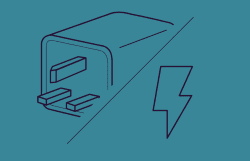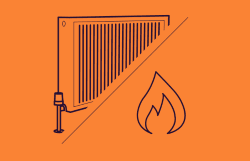Almost everyone knows what the role of energy suppliers is. After all, everyone has to pay their energy bills. Nevertheless, not many people know that there are also other actors involved in getting the energy supply to their premises.
Have you ever heard of Distribution Network Operators? Many people do not realize how important they are. Without them, however, you would not be able to get your energy supply.
A Distribution Network Operator (DNO) is a company licensed to distribute electricity in the UK. They do it by operating the system of pipes, cables, and towers that connect electricity from the national transmission network to homes and businesses across the country. Distribution is an essential aspect of the delivery of energy to energy customers.
If you want to find out more about what DNOs and their role are, keep reading.
A brief history of Distribution Network Operators in the UK
Prior to 1948, the energy market in the UK included hundreds of small companies and a local authority that was responsible for distributing energy to a certain small area. In 1947, however, the Electric Act was passed to nationalise all these companies and to form a countrywide network owned by the government. After that, the government was able to regulate and manage how energy is distributed to various parts of the country.
In 1990, the energy industry was privatised and the area boards were replaced by regional electricity companies. The DNOs that operate today replaced distribution arms of the regional electricity companies. After 1990 energy distribution and supply was divided into several geographical areas while the grid remained a national business.
DNOs have a trade association known as the Energy Networks Association, which is proud to represent the united voice of all DNOs. ENA is responsible not only for bringing together British DNOs but also for providing technical support and expertise to them. The Energy Network Association also supports decision-makers in the following areas:
- Regulation of the energy market
- Representation in the energy market in the UK and abroad
- Cost-efficient engineering solutions
- Health and safety in the energy industry
- Environmentally-friendly solutions in the energy industry
- Promotion and development of smart technologies.
ENA plays a significant role in helping the UK achieve its climate sustainability goals.
Who is involved in keeping our houses bright and warm?
Have a look at the table below to find the overview of key actors involved in making sure that our homes and businesses have a steady supply of gas and electricity.
| Sector | Responsibility |
| Generation | Owning and operating power plants |
| Transmission | Maintaining high voltage transmission networks |
| Distribution | Local distribution via towers, cables, and meters |
| Supply | Selling electricity and billing customers for the energy they consume |
What is a Distribution Network Operator?
Distribution Network Operators are also referred to as DNOs. Their main task is to run the distribution of electricity from the national grid to your house or your business’s premises. DNOs are responsible for the network of overhead lines, cables, pipes, transformers, meters, and towers that deliver energy to your home. These networks are paid for by customers when they pay for their electricity supply bills. DNOs manage the network that the electricity is distributed through, while suppliers sell the electricity that runs through this network.
If you ever experience a power cut, you should never contact your energy supplier as they will not be able to help. Instead, contact your DNO as it is their responsibility to take care of power cuts and restore electricity as soon as possible. If a power cut happens, call 105. The line is free from most landline and mobile numbers.
DNOs are naturally a monopoly but they are regulated by Ofgem to protect consumers from being overcharged.
Who is my DNO?
In the UK, there are 14 licensed DNOs that are owned by six different groups. Each DNO covers a specific geographic area of the UK. That means that customers do not have the freedom to choose their DNO.
Have a look at the table below to find out more about the main DNOs’ groups.
| DNO | region of operation | overview |
| Electricity North West | North West England | Founded in 2007Peter Emery is the CEO0800 195 4141 is the contact number |
| SSE Power Distribution | North Scotland | Scottish and Southern Electricity Networks (SSEN)Founded in 200Employs almost 400 people |
| UK Power Networks | South East England and London | Manages three licensed distribution networks which together cover an area of 30000 square kilometresServes around 8 million customers |
| SP Energy Networks | Merseyside, Cheshire, North Wales and North Shropshire | Founded in 20010800 001 5400 is the contact numberScottish Power is its parent organisation |
| Northern Powergrid | Yorkshire | 0800 375 675 is the contact number Company based in Newcastle Upon Tyne in EnglandEmploys around 2,700 people |
| Western Power Distribution | East Midlands, West Midlands, South Wales & South West England | Trading identity of four electricity distribution companies in the United Kingdom: WPD South West, WPD South Wales and WPD Midlands |
| Northern Ireland Electricity | Northern Ireland | Established in 1993Since 2010 a subsidiary of ESB Group |
You can also have a look at the map of electricity distribution newtworks to verify which one serves the area where you live.
How are DNOs funded?
DNOs work closely with energy suppliers and get their income from them. Energy suppliers include these costs when preparing an energy tariff for their energy customers. The charge to cover the activities of DNOs typically accounts for around 15% of the energy bills. This sum covers the cost of the DNO operating and mainatining the network.
DNOs are regulated by Ofgem that ensures they do not abuse their monopolies. While Ofgem does not dictate the prices, it monitors them and intervenes if the prices introduced by DNOs are not fair to the customers. To make sure customers are being treated well and are not being overcharged, Ofgem regularly conducts price reviews.
One of the reasons why energy tariffs might be more expensive in some areas than in others is because of the local costs associated with the activities of the DNO.
Who regulated DNOs in the UK?
Each DNO is responsible for maintaining and operating the network in one specific area so DNOs automatically have a monopoly. While customers can choose their energy supplier, they are unable to change their DNOs.
To prevent DNOs from abusing their power, Ofgem regulated them through licences. The licences determine, for example, how much revenue each DNO can generate from the customers. Ofgem makes sure that all DNOs operate within their licence agreements and that they treat customers fairly.
In addition to that, all DNOs have to comply with the Electricity Act. They also have to conform to the standard of the Electricity Connections Steering Group and the Electricity Safety, Wuality and Continuity Regulations.
Frequently Asked Questions
What do DNOs do?
DNOs manage distribution networks by operating and maintaining underground and overhead power lines. If there occur any faults in connections, DNOs are responsible for fixing them. They are also charged with overseeing the installation of new connections and making sure that the network is secure.
Who owns DNOs in the UK?
National Grid Electricity Transmission owns and maintains the electricity transmission network in England and Wales. In the UK, there are 14 DNOs and each of them is owned by a different group that covers a distinct region of Britain.
How many DNOs are there?
There are 14 licensed DNOs in the UK. Each of them is responsible for a separate geographical area of the UK.
What to do if there is a power cut?
If you want to report a power cut, contact the DNO for your area. If you are not sure who your DNO is, call 105 and the line will automatically connect you to your local DNO. If you visit the website of your DNO, you will be able to track a live map of power cuts in your area.
Is National Grid a DNO?
National Grid is not a DNO. National Grid refers to a network made of high-voltage power lines, gas pipelines, storage facilities, and other infrastructure elements that enable the distribution of electricity.
DNOs deliver electricity from the National Grid to homes and businesses across the UK.



